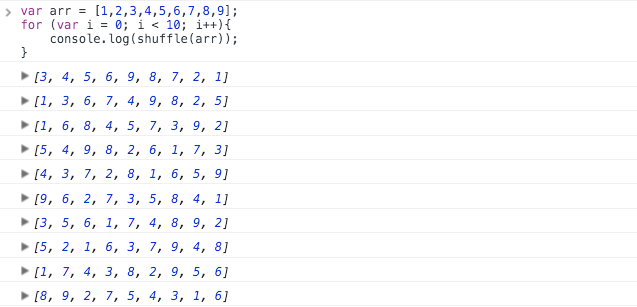JavaScript study notes: Random sorting of arrays_javascript skills
Recommended reading: JavaScript Study Notes Array Sum Method
Add, delete, modify and check arrays of JavaScript study notes
JavaScript provides sort() and reverse() methods to reorder array items. But many times these two methods cannot meet the needs of our actual business, such as random shuffling in poker games.

In this article, let’s learn how to achieve the effect of the above example, as well as some related knowledge about random sorting of arrays.
I checked the relevant information about random sorting of arrays on the Internet, and I saw Math.random(). Open the browser controller and enter:
Math.random()

As can be seen from the picture, Math.random() obtains a random number between 0 and 1. As we all know, sort() can call a function as a parameter. If the function returns a value of -1, it means that item a in the array is ranked before item b. In this way, you can write a random function to compare the number randomly generated by Math.random() with 0.5. If it is greater than .5, it will return -1 (a is ranked in front of b), otherwise it will return 1 (b is ranked in front of a):
function randomSort(a, b) {
return Math.random() > 0.5 ? -1 : 1;
}Look at an example:
var arr = [1,2,3,4,5,6,7,8,9]; arr.sort(randomSort);

In this way, the example effect at the beginning of the article can be achieved:
Although the previous method achieves random sorting of the array, it always feels that the position of each element sent to the new array is not random. Just like the previous example, the element with value 1 in array arr has its original key value 0. After random sorting, the probability of the key value 1 being 0-8 is the same. Then it is decreasing here because the sort() method compares sequentially.
To address this phenomenon, we can use the following recursive method to deal with it:
function randomSort(arr, newArr) {
// 如果原数组arr的length值等于1时,原数组只有一个值,其键值为0
// 同时将这个值push到新数组newArr中
if(arr.length == 1) {
newArr.push(arr[0]);
return newArr; // 相当于递归退出
}
// 在原数组length基础上取出一个随机数
var random = Math.ceil(Math.random() * arr.length) - 1;
// 将原数组中的随机一个值push到新数组newArr中
newArr.push(arr[random]);
// 对应删除原数组arr的对应数组项
arr.splice(random,1);
return randomSort(arr, newArr);
}In this case, we can use it like this:
for (var i = 0; i < 10; i++) {
var arr=[1,2,3,4,5,6,7,8,9];
var newArr=[];
randomSort(arr,newArr);
console.log(newArr);
}Output result:

After executing the randomSort(arr, newArr) function, the original array arr is cleared.
If you use this method to do the shuffling example at the beginning of the article, you need to reset the pukePic array in the resetPic() function:
In addition to the above two methods, @Traveller shared an article "Implementation of Randomized Sorting Algorithm for Array Elements" on DIV.IO. This article provides three implementation methods for random sorting of array items:
Use the array sort method to randomly sort the array elements
Array.prototype.shuffle = function(n) {
var len = this.length ,
num = n ? Math.min(n,len) : len,
arr = this.slice(0);
arr.sort(function(a,b){
return Math.random()-0.5;
});
return arr.slice(0,num-1);
}Randomly swap elements in the array
lib = {}
lib.range = function(min,max) {
return min + Math.floor(Math.random()*(max-min+1));
}
Array.prototype.shuffle = function(n) {
var len = this.length,
num = n ? Math.min(n,len) : len,
arr = this.slice(0),
temp,
index;
for (var i=0;i<len;i++){
index = lib.range(i,len-1);
temp = arr[i];
arr[i] = arr[index];
arr[index]=temp;
}
return arr.slice(0,num);
}Randomly extract an element from the original array and add it to the new array
lib = {}
lib.range = function(min,max) {
return min+Math.floor(Math.random()*(max-min+1));
}
Array.prototype.shuffle = function(n) {
var len = this.length,
num = n ? Math.min(n,len) : len,
arr = this.slice(0),
result=[],
index;
for (var i=0;i<num;i++){
index = lib.range(0,len-1-i);
// 或者 result.concat(arr.splice(index,1))
result.push(arr.splice(index,1)[0]);
}
return result
}Shuffling algorithm
The basic principle of random sorting of arrays is the shuffling algorithm (Fisher–Yates shuffle):
is an algorithm that disrupts the order of finite sets
Principle
Define an array (shuffled), the length (length) is the length of the original array (arr)
Take 0 to index (initial 0) random value rand, shuffled[index] = shuffled[rand], shuffled[rand] = arr[index]
index++ ; Repeat step 2 until index = length -1
It is the assignment process of shuffled from 0 to length-1, and the newly added value is arr[index]. The value of shuffled[index] is the random value shuffled[rand] among the assigned elements, because there will be two duplicates. value, so shuffled[rand] is equal to the newly added value arr[index]
shuffle method in underscore.js
function random(min, max) {
if (max == null) {
max = min;
min = 0;
}
return min + Math.floor(Math.random() * (max - min + 1));
};
function shuffle(arr) {
var length = arr.length,
shuffled = Array(length);
for (var index = 0, rand; index < length; index++) {
rand = random(0, index);
if (rand !== index) shuffled[index] = shuffled[rand];
shuffled[rand] = arr[index];
}
return shuffled;
}Practical application:
var arr = [1,2,3,4,5,6,7,8,9];
for (var i = 0; i < 10; i++){
console.log(shuffle(arr));
}The results output by Chrome are as follows:

Similarly, use the shuffling algorithm to complete the example at the beginning of the article:

There is also a simpler and easier to understand way of writing:
function shuffle(arr) {
var i,
j,
temp;
for (i = arr.length - 1; i > 0; i--) {
j = Math.floor(Math.random() * (i + 1));
temp = arr[i];
arr[i] = arr[j];
arr[j] = temp;
}
return arr;
};Summary
This article mainly summarizes and collects relevant information about random sorting of arrays. Of course, there are many ways to achieve similar functions in the market. These are just collected and organized here. If you have a better method, please share it with us in the comments.
The above content is an introduction to the random sorting of arrays in JavaScript study notes introduced by the editor. I hope it will be helpful to you!

Hot AI Tools

Undresser.AI Undress
AI-powered app for creating realistic nude photos

AI Clothes Remover
Online AI tool for removing clothes from photos.

Undress AI Tool
Undress images for free

Clothoff.io
AI clothes remover

Video Face Swap
Swap faces in any video effortlessly with our completely free AI face swap tool!

Hot Article

Hot Tools

Notepad++7.3.1
Easy-to-use and free code editor

SublimeText3 Chinese version
Chinese version, very easy to use

Zend Studio 13.0.1
Powerful PHP integrated development environment

Dreamweaver CS6
Visual web development tools

SublimeText3 Mac version
God-level code editing software (SublimeText3)

Hot Topics
 What should I do if I encounter garbled code printing for front-end thermal paper receipts?
Apr 04, 2025 pm 02:42 PM
What should I do if I encounter garbled code printing for front-end thermal paper receipts?
Apr 04, 2025 pm 02:42 PM
Frequently Asked Questions and Solutions for Front-end Thermal Paper Ticket Printing In Front-end Development, Ticket Printing is a common requirement. However, many developers are implementing...
 Demystifying JavaScript: What It Does and Why It Matters
Apr 09, 2025 am 12:07 AM
Demystifying JavaScript: What It Does and Why It Matters
Apr 09, 2025 am 12:07 AM
JavaScript is the cornerstone of modern web development, and its main functions include event-driven programming, dynamic content generation and asynchronous programming. 1) Event-driven programming allows web pages to change dynamically according to user operations. 2) Dynamic content generation allows page content to be adjusted according to conditions. 3) Asynchronous programming ensures that the user interface is not blocked. JavaScript is widely used in web interaction, single-page application and server-side development, greatly improving the flexibility of user experience and cross-platform development.
 Who gets paid more Python or JavaScript?
Apr 04, 2025 am 12:09 AM
Who gets paid more Python or JavaScript?
Apr 04, 2025 am 12:09 AM
There is no absolute salary for Python and JavaScript developers, depending on skills and industry needs. 1. Python may be paid more in data science and machine learning. 2. JavaScript has great demand in front-end and full-stack development, and its salary is also considerable. 3. Influencing factors include experience, geographical location, company size and specific skills.
 How to merge array elements with the same ID into one object using JavaScript?
Apr 04, 2025 pm 05:09 PM
How to merge array elements with the same ID into one object using JavaScript?
Apr 04, 2025 pm 05:09 PM
How to merge array elements with the same ID into one object in JavaScript? When processing data, we often encounter the need to have the same ID...
 Is JavaScript hard to learn?
Apr 03, 2025 am 12:20 AM
Is JavaScript hard to learn?
Apr 03, 2025 am 12:20 AM
Learning JavaScript is not difficult, but it is challenging. 1) Understand basic concepts such as variables, data types, functions, etc. 2) Master asynchronous programming and implement it through event loops. 3) Use DOM operations and Promise to handle asynchronous requests. 4) Avoid common mistakes and use debugging techniques. 5) Optimize performance and follow best practices.
 How to achieve parallax scrolling and element animation effects, like Shiseido's official website?
or:
How can we achieve the animation effect accompanied by page scrolling like Shiseido's official website?
Apr 04, 2025 pm 05:36 PM
How to achieve parallax scrolling and element animation effects, like Shiseido's official website?
or:
How can we achieve the animation effect accompanied by page scrolling like Shiseido's official website?
Apr 04, 2025 pm 05:36 PM
Discussion on the realization of parallax scrolling and element animation effects in this article will explore how to achieve similar to Shiseido official website (https://www.shiseido.co.jp/sb/wonderland/)...
 The Evolution of JavaScript: Current Trends and Future Prospects
Apr 10, 2025 am 09:33 AM
The Evolution of JavaScript: Current Trends and Future Prospects
Apr 10, 2025 am 09:33 AM
The latest trends in JavaScript include the rise of TypeScript, the popularity of modern frameworks and libraries, and the application of WebAssembly. Future prospects cover more powerful type systems, the development of server-side JavaScript, the expansion of artificial intelligence and machine learning, and the potential of IoT and edge computing.
 The difference in console.log output result: Why are the two calls different?
Apr 04, 2025 pm 05:12 PM
The difference in console.log output result: Why are the two calls different?
Apr 04, 2025 pm 05:12 PM
In-depth discussion of the root causes of the difference in console.log output. This article will analyze the differences in the output results of console.log function in a piece of code and explain the reasons behind it. �...






